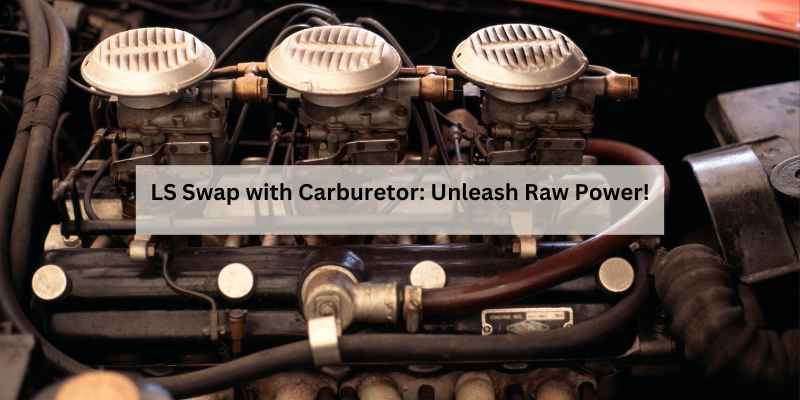LS Swap with Carburetor: Unleash Raw Power!
An LS swap with a carburetor involves replacing a vehicle’s original engine with an LS engine and using a carburetor for fuel delivery. This setup simplifies tuning and enhances performance for many enthusiasts.
An LS swap with a carburetor is an increasingly popular modification among car enthusiasts. This conversion allows drivers to harness the power of LS engines while maintaining simplicity and ease of tuning through carburetor systems. Many opt for this setup to enhance performance without the complexity of fuel injection systems.
The LS engine offers a lightweight design, improved reliability, and substantial horsepower gains. Carburetors provide straightforward adjustments and a classic feel, appealing to those who appreciate vintage performance. This combination can transform vehicles into powerful machines, making it a favorite choice for both street and track applications. Explore the benefits and considerations of this exciting engine swap.
Introduction To Ls Swaps
LS swaps are popular for many reasons. They offer great power and efficiency. Choosing an LS engine provides reliability and performance. Many enthusiasts prefer the LS series for its lightweight design and easy upgrades.
Carbureted LS engines have their advantages. They are simpler to work on. They often provide a more classic feel. Fuel injected LS engines offer better fuel efficiency and performance tuning. Each option has its own unique benefits based on your preferences.
| Feature | Carbureted LS Engines | Fuel Injected LS Engines |
|---|---|---|
| Maintenance | Easy to maintain | Requires specialized tools |
| Power Delivery | Responsive throttle | Consistent power |
| Tuning | Simple tuning options | Advanced tuning capabilities |
Benefits Of A Carbureted Ls Swap
Carbureted LS swaps offer great advantages in terms of simplicity and reliability. Using a carburetor makes setup easier. It avoids the need for complex fuel injection systems. This leads to fewer parts that can fail.
Many car enthusiasts appreciate the performance gains from a carbureted LS engine. Carburetors can provide better throttle response. They also allow for easier tuning to fit specific needs. This means drivers can enjoy a more exciting ride.
Choosing The Right Ls Engine
Choosing the right LS engine is crucial for a successful swap. Different engine variants offer unique characteristics. Options include the LS1, LS2, LS3, LS6, and LS7. Each variant has specific power ratings and features.
LS1 engines are great for beginners. They provide around 350 horsepower. The LS2 offers more power, reaching 400 horsepower. For higher performance, the LS3 can deliver 430 horsepower. The LS6 is known for its high-revving capabilities, while the LS7 features a larger displacement for extreme builds.
When buying a used LS engine, check for leaks and wear. Inspect the engine for rust and damage. Verify the mileage and service history. A well-maintained engine will perform better. Research prices to ensure a fair deal.
Carburetor Selection For Your Ls Swap
Choosing the right carburetor for your LS swap is very important. Several types fit well with LS engines. Some popular options include:
- Holley 750 CFM – Great for performance and power.
- Quick Fuel Technology – Offers adjustable features for better tuning.
- Edelbrock 650 CFM – A reliable choice for street applications.
Tuning the carburetor ensures optimal performance. Start by adjusting the idle speed. Check the air-fuel mixture for best results. Changing the jets can help match your engine needs. Regular maintenance keeps everything running smoothly.
Essential Modifications For Carbureted Ls Swaps
Choosing the right intake manifold is crucial for your LS swap. Options include single-plane and dual-plane manifolds. Single-plane manifolds boost top-end power. Dual-plane manifolds improve low-end torque. Consider your driving style and engine goals before making a choice.
Upgrading the ignition system enhances performance. A high-output coil provides a stronger spark. Use aftermarket spark plugs for better combustion. An MSD ignition box can improve timing and efficiency. Ensure your wiring is secure and meets the new system’s demands.
Fuel System Considerations
Choosing the right fuel pump is crucial for your LS swap. A mechanical or electric pump can work, but ensure it meets the engine’s needs. Most LS carburetors require 6-8 psi for optimal performance.
For the fuel line, use AN fittings for a secure connection. Select a line that can handle the necessary pressure. Fuel filters are essential to keep the system clean. Use filters rated for at least 100 microns to catch debris.
| Component | Recommendation |
|---|---|
| Fuel Pump | 6-8 psi, mechanical or electric |
| Fuel Line | AN fittings, pressure rated |
| Fuel Filter | 100 microns or better |
Exhaust And Cooling System Mods
Choosing the right exhaust setup is crucial for your LS swap. A good exhaust system helps improve engine performance. Consider options like headers and full exhaust kits. Stainless steel materials offer durability and corrosion resistance.
For optimal performance, select a system that matches your engine’s power output. This ensures smooth airflow and better sound. A well-designed exhaust can also enhance your vehicle’s fuel efficiency.
Cooling system upgrades can significantly boost your engine’s performance. A high-capacity radiator allows for better heat dissipation. Installing an electric fan can improve airflow and reduce engine temperatures.
Consider using a performance water pump for better coolant flow. Upgrading hoses to silicone can increase reliability. These modifications help keep your engine running cool and efficient.
Installation Tips And Tricks
Mounting the Engine requires careful planning. First, ensure the engine mounts fit well. Use solid mounts for better stability. Align the engine with the transmission properly. Check clearances for the hood and other parts. Adjust as needed for a good fit.
Wiring and Electrical Connections play a key role in your swap. Start by connecting the battery to the starter. Use quality wires to avoid issues. Connect the ignition system carefully. Ensure all grounds are secure for safety. Test each connection before proceeding.
Tuning Your Carbureted Ls For Maximum Power
Adjusting the air/fuel ratio is crucial for your carbureted LS engine. A proper ratio improves performance and efficiency. Aim for a mixture of 13:1 to 14.7:1 for optimal power.
Use a wideband O2 sensor to monitor the ratios accurately. Make small adjustments to the carburetor jets for precise tuning. Ensure the float level is set correctly to avoid flooding.
Timing also plays a significant role in performance. Set the initial timing to around 12-16 degrees for best results. Check the spark plug gap to ensure proper ignition.
Consider using high-performance spark plugs for better efficiency. Regularly inspect and replace worn plugs to maintain engine health.
Real-world Examples And Success Stories
Many car enthusiasts have achieved great results with an LS swap using a carburetor. One notable case is a 1970 Chevrolet Nova. The owner swapped in a 5.3L LS engine with a Holley carburetor. This setup boosted performance significantly.
Another success story involves a 1992 Chevrolet C1500. The owner installed a 6.0L LS engine paired with an Edelbrock carburetor. This swap provided excellent torque and power for towing.
Inspiration can also be found in the Ford Mustang community. A 2000 Mustang GT received a 5.7L LS engine with a Quick Fuel carburetor. Owners rave about the improved throttle response and reliability.
These real-world examples show how an LS swap can transform your vehicle. With careful planning, great results are achievable.
Frequently Asked Questions
Can You Run An Ls Engine With A Carburetor?
Yes, you can run an LS engine with a carburetor. This setup requires an intake manifold designed for carburetors. The engine will perform well with proper tuning. Many enthusiasts prefer this option for simplicity and ease of modification. It offers a classic performance feel.
Why Put A Carb On An Ls?
Installing a carburetor on an LS engine simplifies tuning and enhances throttle response. It can also improve performance in specific applications, such as racing. Carburetors often provide a more classic feel, appealing to enthusiasts who prefer traditional setups over modern fuel injection systems.
What Size Carburetor For 5.3 Ls?
For a 5. 3 LS engine, a carburetor size of 750 to 850 CFM is ideal. This range optimizes performance and fuel efficiency. Choosing the right size enhances throttle response and overall power output. Always consider your specific application and modifications for the best results.
Which Ls Engine Is Best For Swaps?
The LS3 engine is often considered the best for swaps. It offers a great balance of power and reliability. With 430 horsepower, it fits various projects easily. The LS1 and LS6 are also popular choices for their performance and availability.
Choose based on your specific needs and budget.
Conclusion
LS swapping with a carburetor offers a unique blend of power and simplicity. This approach enhances performance while maintaining a classic feel. Whether you’re a seasoned mechanic or a DIY enthusiast, this swap can elevate your vehicle’s capabilities. Embrace the challenge and enjoy the rewards that come with it.







